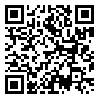Volume 3, Issue 4 (2022)
2022, 3(4): 74-91 |
Back to browse issues page
1- PhD Candidate in Architecture, Department of Architecture, South Tehran Branch, Islamic Azad
2- Assistant Professor, Department of Architecture, South Tehran Branch, Islamic Azad University, Tehran, Iran ,aamalekafzali@yahoo.com
3- Faculty member, Road, Housing and Urban Development Research Center (BHRC), Tehran, Iran
2- Assistant Professor, Department of Architecture, South Tehran Branch, Islamic Azad University, Tehran, Iran ,
3- Faculty member, Road, Housing and Urban Development Research Center (BHRC), Tehran, Iran
Abstract: (1219 Views)
Objectives: Today, the expansion of urbanization is associated with the disappearance of human activities in the space between buildings. The purpose of this research is to understand the dimensions of the connection between buildings and the city and how it is captured by the dispositive, and finally to find a way to emancipate in the form of an immanent connection.
Method: The research is done by a qualitative method. The research paradigm is emancipation, the strategy is discourse analysis and the tactics are data collection, coding, analysis, display, explanation, and profanation.
Result : The findings indicate that the building and the city connection factors are related to each other through a hidden network in the form of three scales: the large scale includes semantic factors, the medium scale social factors, and the small scale include formal and functional-behavioral aspects. Therefore, social institutions on a medium scale, will be captured by the dispositive after constituting as they have a specific form and function, and will lose their relationship with the large scale and exist officially in the form of a formal institution, which ultimately leads increasing control and power, and further disintegration.
Conclusion: To achieve an immanent connection between the building and the city, the official institution should be disabled to reconnect the semantic scale for redefining the social institution. Also, it should be profane from whatever dispositive has been placed on the concept of institution. This is realized by the presence of non-institution in the space between the buildings
Method: The research is done by a qualitative method. The research paradigm is emancipation, the strategy is discourse analysis and the tactics are data collection, coding, analysis, display, explanation, and profanation.
Result : The findings indicate that the building and the city connection factors are related to each other through a hidden network in the form of three scales: the large scale includes semantic factors, the medium scale social factors, and the small scale include formal and functional-behavioral aspects. Therefore, social institutions on a medium scale, will be captured by the dispositive after constituting as they have a specific form and function, and will lose their relationship with the large scale and exist officially in the form of a formal institution, which ultimately leads increasing control and power, and further disintegration.
Conclusion: To achieve an immanent connection between the building and the city, the official institution should be disabled to reconnect the semantic scale for redefining the social institution. Also, it should be profane from whatever dispositive has been placed on the concept of institution. This is realized by the presence of non-institution in the space between the buildings
Keywords: connection of the building and the city, the dispositive, social institutions, measurement and un measurement area, non-institution
Article Type: Original Research |
Subject:
Quality of Urban Public Spaces
Received: 2022/08/27 | Accepted: 2022/09/28 | Published: 2022/12/31
Received: 2022/08/27 | Accepted: 2022/09/28 | Published: 2022/12/31
| Rights and permissions | |
 |
This work is licensed under a Creative Commons Attribution-NonCommercial 4.0 International License. |


